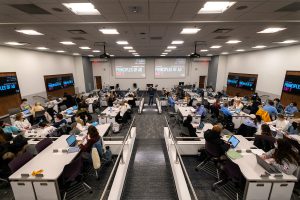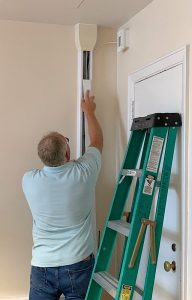November is National Gratitude Month and ITS is giving thanks for the behind-the-scenes teams and work that keep the University running.
It’s easy to take IT services for granted — we expect 24/7 access and uptime to our email, websites, documents, storage and Wi-Fi. Disruptions are noticeable, but we don’t notice when everything is working smoothly.
ITS’ mission, in direct support of the University’s mission, is to accelerate the University’s academic and research pursuits by providing accessible, reliable, efficient, scalable and innovative technologies.
And what binds both the ITS and the University mission together is service. ITS is committed to providing the services, both technological and human, that we rely on to power high impact teaching, learning and research.
Service Desk and Managed Desktop Support

At some point during our time at Carolina, most of us will need tech help.
Whether it’s visiting the walk-in in the basement of the Undergraduate Library, calling 919-962-HELP, using the service portal at help.unc.edu or interacting via chat, the ITS Service Desk provides direct tech support to all campus users.
Each one of those points of contact is tracked, and so far this fiscal year, ITS has received and closed about 66,000 tickets and interactions. That’s equivalent to a request for help or services every two and a half minutes, 24 hours a day.
When the Service Desk receives a ticket, it can resolve almost 90% at “first call.” This means solving problems or answering questions without escalation or routing to other units in ITS or to departmental IT. The Service Desk’s customer satisfaction survey response averages almost 97% and the time to answer for all methods of contacting the Service Desk ranges from as little as 30 seconds to a little over two minutes, with the longest wait times at the beginning of the semester. However you slice it, the Service Desk provides a fast response with a high satisfaction value.
For staff in 15 University departments, Managed Desktop Support (MDS) is the unit to rely on for device support. MDS supports the entire lifecycle of almost 1,500 laptops, desktops and smartphones across campus. This means MDS does more than just hand over a computer on your first day. It also means that MDS handles keeping the software up to date. And in the past 12 months, MDS has deployed almost 2.5 million software patches to devices they support.
Educational Technologies
Teaching and learning are the core of the University teaching and learning mission, and ITS Educational Technologies (EdTech) manages essential services for both in-person and virtual learning.

Classroom Hotline supports 198 general purpose classrooms on campus. The unit not only plans and manages the classroom technology in the spaces, like cameras, lecterns and projectors, but also supports the 1,100 instructors who use the classrooms when they have tech trouble. For a sense of scope, each undergraduate student sits in one of the 10,461 general purpose classroom seats during that student’s time at Carolina.
EdTech supports the two campus learning management systems, Sakai and Canvas. Currently there are 4,220 classes in both systems, with 871 instructors using Canvas and 1,969 using Sakai.
And EdTech’s support of digital learning spaces extends to Zoom and Panopto. In the past year UNC-Chapel Hill has held 1.16 million Zoom meetings, for an average of just under 3,200 meetings per day. And this year, there have been 90,000 videos created on Panopto — and one million views. This means someone across the campus community starts watching a Panopto video every 30 seconds, 24 hours a day, 365 days a year.
Infrastructure & Operations
The most behind-the-scenes work ITS does to keep the University running is within its Infrastructure & Operations (I&O) division. Infrastructure & Operations supports key services like Microsoft 365, networking, campus data centers, the campus cellular antenna system and more.
Much of this critical work isn’t visible to end users, like the 1.6 million automated campus database updates to ConnectCarolina and other campus databases each month.

But some of the division’s work is easy for us to see. Microsoft 365 is one of campus’ most used services, meaning that its 99.9% uptime in the third quarter of this year was essential. Here at Carolina, our email traffic averages 1.5 million messages received daily, Monday through Friday. All that mail adds up to 452 terabytes of mailbox usage, just a little less than the 541 terabytes stored on OneDrive.
And how would we work and learn without internet access on campus?
ITS Networking has deployed 11,072 wireless access points on campus and replaced more than 1,000 in the residence halls this past summer. This semester, UNC wireless networks peaked at nearly 48,000 concurrent-connected devices — a post-COVID record.
To keep the campus networks running, Networking invests more than $2.5 million annually in life cycle refresh. This means replacing switches and access points to provide the fastest and most reliable internet to campus.
